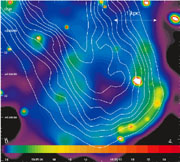


As described in the previous section, there is currently no direct evidence for strong-shock heating in cooling flow clusters from the current outburst of the radio source. The temperature maps reveal that the compressed ICM in the shells surrounding the radio bubbles is cool.
It is worth mentioning here examples of what appears to be shock
heating of X-ray-emitting gas by a radio source. The first, and
more obvious case, is that of the nearby radio galaxy,
Centaurus A.
This E galaxy was observed with Chandra and XMM-Newton, as
described in
Kraft et al. (2003).
It is the nearest active galaxy, at a
distance of 3.4 Mpc. The radio source is a double-lobed FR I with a power
of 1.9 × 1024 W Hz-1 at 1.4 GHz. There is a
shell or cap of emission
seen in the X-ray along the edge of the SW radio lobe. This feature was
interpreted as shocked interstellar medium (ISM), and exhibits a
temperature and pressure that are higher than its surroundings. The
pressure jump is consistent with a shock with a Mach number of
 = 8.5.
The brightened cap of emission is shown in Fig. 10
(Kraft et al. 2003).
While the shocked gas here is ISM, rather than ICM, it still
represents the type of signature we might expect to see in cluster gas that
has been shocked by a radio source.
= 8.5.
The brightened cap of emission is shown in Fig. 10
(Kraft et al. 2003).
While the shocked gas here is ISM, rather than ICM, it still
represents the type of signature we might expect to see in cluster gas that
has been shocked by a radio source.
 |
Figure 10. Adaptively-smoothed Chandra image of the SW lobe of Cen A, with radio contours superposed (Kraft et al. 2003). The bright cap of emission is thought to be ISM that has been shocked by the radio source. |
Another case is the elliptical galaxy NGC 4636. This galaxy is located in
the outer part of the Virgo cluster. The Chandra image
(Jones et al. 2002)
shows bright arm-like features with sharp edges. These arm-like
features have higher temperatures and pressures than the surrounding gas,
consistent with gas that experienced a shock with Mach number
 = 1.73. However, there is
no strong radio source that currently corresponds with the arm-like
features, and they may or may not result from a previous radio outburst.
= 1.73. However, there is
no strong radio source that currently corresponds with the arm-like
features, and they may or may not result from a previous radio outburst.